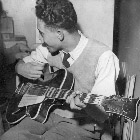| |
| 1955 [CD 22-23; AK 26-27] |
| They work with various skiffle
and blues groups. They close their skiffle club and re-open as the Blues
and Barrelhouse Club (a room of the Round House pub, also on Wardour).
They feature American blues artists such "Big" Bill Broonzy, Muddy Waters,
Sonny Terry and Brownie McGhee, many of whom stay with Korner and family
(Bayswater). |
| |
| 1961 [CD 28-29, AK 32-33] |
| Davies and Koerner try electric
blues after hearing Muddy Waters . . . , and are ejected by the Roundhouse
(Soho). |
| |
| 1962 [CD 29-30, AK 33-34] |
| 17 March: Korner and
Davies form Blues Incorporated as an outlet for their musical interests
and include at various times Charlie Watts, Mick Jagger, Keith Richard,
Brian Jones, Long John Baldry, Paul Jones, Graham Bond, Dick Heckstall-Smith,
Eric Burdon, and Ginger Baker. |
| Audiences who imagined themselves
to be purists insisted that "real" blues performances were acoustic.
These audiences had impressed this on American performers such as Muddy
Waters by rejecting him as an electric musician. His return tour in the
late 50s was acoustic. However, by the early 1960s, Blues Incorporated
began performing electric blues and eventually their landlords on Wardour
Street evict them. They moved their club out to the western suburbs and
established the Ealing [Blues] Club (downstairs from the ABC tearooms, opposite
Ealing Broadway tube station). However, one of the places in Soho where
they could still play was the Marquee where they recorded and album, R&B
at the Marquee. Gradually, radio programs, such as the BBC's Band
Beat, began to accept performances of tunes already in the trad tradition
such as "Everything She Needs." |
